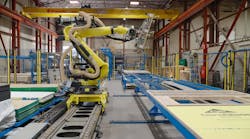A new data model developed by researchers at the U.S. Department of Energy’s Lawrence Berkeley National Laboratory and their colleagues at other universities and in the private sector will help facilities and buildings save power through automated-demand-response technology and advance the development of the “Smart Grid.”
The researchers who developed Open Automated Demand Response (OpenADR) are part of the Demand Response Research Center (DRRC), a center funded by the California Energy Commission’s Public Interest Energy Research Program. The DRRC’s goal is to develop technologies to make it possible for buildings and facilities to adopt demand response as a way of saving peak power use and reducing stress on the electric grid during times of high energy demand.
“The purpose of this specification is to help building and facilities managers implement automated demand response in their facilities as well as assist electric utilities to help their commercial and industrial customers participate in power pricing programs that incorporate automated demand response,” Mary Ann Piette, deputy head of the building technologies department and research director of the DRRC, said.
“OpenADR also helps manufacturers of building-automation equipment design products for Smart Grid implementation and power aggregators incorporate demand response into their work. OpenADR builds on six years of research in California to develop auto DR technology and demonstrate it in buildings with our utility and commercial partners,” she said.
With widespread interest nationally in turning the electric grid into a “Smart Grid,” the OpenADR specification will help more facilities adopt, and building-automation companies develop, products for Auto Demand Response (AutoDR), by providing a common, open specification that all parties can use as a reference.
What is DR and Auto DR?
DR is a central part of the so-called “Smart Grid.” It is the process of managing energy use dynamically through cooperation among power customers, their electric utility, and the electric system’s operator (the independent system operator [ISO]). When the electrical grid is near capacity for any reason—for example, when too many air conditioners start laboring on a hot summer’s day—the ISO informs electric utilities and power consumers that there is a problem in the offing.
While shutting building systems down by hand can help reduce overall electric demand, manual interventions are not always reliable, consistent, or persistent. AutoDR provides an automated alternative to manual response.
AutoDR is the technology and communications platform developed by the DRRC, which was launched by the California Energy Commission’s Public Interest Energy Research (PIER) program at Berkeley Lab in 2003, to support all forms of demand response. Under Piette’s direction, the DRRC manages a portfolio of research projects that address pricing, valuation, behavior, building dynamics, and technology development.
Features of OpenADR
“The OpenADR Specification uses open, non-proprietary, industry-approved data models—any interested party can develop products around it. Its communications interfaces and protocols are flexible, platform-independent, interoperable, and transparent to end-to-end technologies and software systems,” Piette said.
An open specification helps encourage innovation and interoperability. It allows system designers to build on existing controls and communications strategies used within their facilities to reduce technology operation and maintenance costs, stranded assets, and obsolesce in technology.
System designers can integrate their facilities energy-management and control systems, centralized lighting, and other end-use devices that can receive a relay or Internet signals using, for example, eXtensible Markup Language.
The specification includes provisions for including opt-out or override functions through a Web portal. Research on facility-manager preferences suggest that providing manual control over automatic, pre-programmed changes in building energy use is an essential feature for facility managers interested in joining utility DR programs.








